The Lexicon Project 2005
Behind the Scenes of this Local Photo Project
By Justin T. E. Smith
![]()
![]()
This historical documentation is the brainchild of three ambiguous and creative local minds. Photographers Jonathan Rodgers are both Lexington natives who flew the coop to pursue creative endeavors. Rodgers shot for National Geographic; Schankula researched under Michael Moore for Fahrenheit 9/11.
Upon return, they saw a city ripe for a movement of this sort. Along with co-founder and art manager Marcie Crum, they came together two years ago with a common belief in this great little city and the goal to capture it not for what it is, but for who it is.



Here’s how it works. Hundreds of pictures are taken across town, all the time. Any function might be fair game… Any willing participant, any passersby. Pictures are continually taken of the city, of its rhythmic breathing as everyone goes about their daily grind. For every day, there is a photograph. For every month, there are 30 or 31 images (unless you’re February).
January’s premier exhibit — featuring images from the past year—focused on faith and values, following a month riddled with rigorous religious practices. Featured were shots of Christmas day – bored shopkeeps and empty parking lots, Menorah-toting mothers and gaggles of Santas. A mosque off Georgetown Road. A candlelit Catholic mass. All of these are pieces of one puzzle: the religious and spiritual infrastructure of this city.
February’s collection will no doubt reveal people in all pockets of Lexington.
(The unveiling was Thursday January 27th at Gallerie Soleil—after which, the work was dispersed throughout the city, and you’ll find it adorning the windows of downtown businesses.)
Calvert McCann tried a similar project here in the 1960s, when, as high school student, he photographed a Kentucky torn by civil rights. His pictures even included Martin Luther King, Jr. To his dismay, no one took notice of his work, including the Lexington Herald-Leader. His film went into a drawer, and McCann left for the Peace Corps. Today, he stands as documenting one of the most controversial times in our state’s history.
A Clean Slate
The Lexicon Project is far more visible and gained quick notoriety when they began attending political events carrying camera equipment and the simple white backdrop that has become the “great white hype.”
As if taking pictures of all the people and on-goings wouldn’t attract enough attention, it’s the unassuming yet conspicuous white-sheet backdrop that really turned heads.”It has no motive, no politics, and it’s non-threatening,” says Rodgers. The white sheet is an entity and character of the pictures just as much as the people in them. Think of it as a mile marker, or a dot on a map. The backdrop is rarely used as an actual backdrop to frame the picture; it’s within the picture. It serves to say, “I am here.”



It also cleans the slate for those being photographed. The white sheet, lacking all bias, allows the person to be seen for who they are, not just where they are. “We are proving that it is possible to be objective in media.” That is what this is— not art, but objective media. Story-telling. Documenting.
Mayor Isaac says of Lexicon, “This is a great project… Whenever we see them, we know who they are. We know what they are doing. It’s such a creative way of showing what is going on in our community. They are the watchdogs of our intimate society.”
A recent City Council meeting on water company ownership was a monumental moment in the city, surely meriting documentation, whether or not it turned out to be the final nail in the coffin of discussion on the issue which has occupied local dialogue for years now. The Lexicon Project stormed in, respectfully, to memorex this moment, this place in our time.
Smile.
![]()
![]()
The holidays swallowed Lexington whole, and they captured it in all facets and faces. Ideas include media, taxes, whatever affects the people.
“The project communicates all the similarities and differences that we as a community share” says Schankula.
“It’s the same city, no matter how different your views or beliefs, and we are catching that.”
“People live so much of their lives outside of where they are—through television and internet, ” he adds.
“We are showing that things are going on in your town.”
The Lexicon Project is Lexington right now, this year.
What is happening now, what we face day-to-day, will be illustrated 100 years from now due to their work. In such an interesting time to be alive, the Lexicon Project is capturing the guts of it all.
You can stay updated on the project’s images by visiting lexiconproject.com. Many are reprinted here, with the permission of the project.






